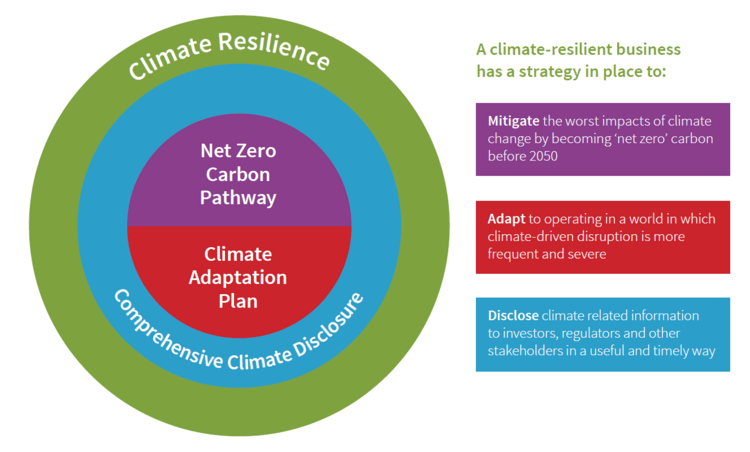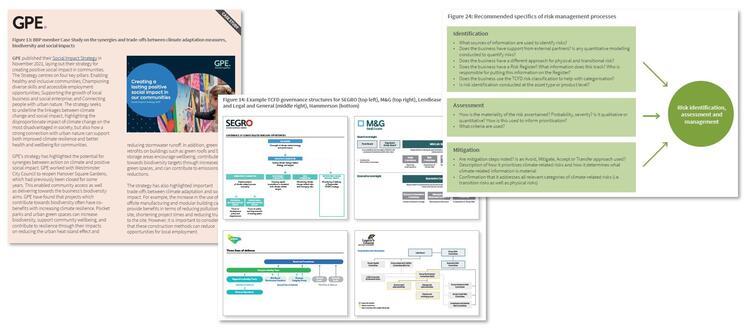Highlights: Climate Resilience in Commercial Real Estate
01 February 2023Highlights: Climate Resilience in Commercial Real Estate
01 February 2023The impact of climate change on the built environment is becoming increasingly apparent, and this will continue unless substantial and urgent action is taken to cut emissions. For property owners, understanding and managing physical and transitional climate risks is becoming increasingly important, and building these considerations into organisational strategies will be key. The Better Buildings Partnership’s Climate Resilience Working Group is a forum for learning, debate and developing practical outputs for members on this challenge.
In September 2022, the Better Buildings Partnership launched a Guide to Climate Resilience Strategies for Commercial Real Estate, freely available on the BBP website. This article shares some of the key highlights of the guide, and how we expect it will be used by BBP members.
The need for climate resilience guidance
The guide was created to support signatories of the BBP Climate Commitment, and the wider commercial real estate sector, to integrate climate resilience measures across their portfolios and develop climate resilience strategies. The guide combines BBP analysis of TCFD-aligned reporting, case studies from members of their approach to managing climate resilience, and industry guidance and best practice examples in climate adaptation measures and disclosure.
Defining Climate Resilience for real estate
The BBP’s guide provides real estate companies with a working definition for climate resilience which can be used consistently across the industry. This definition implies three components for climate resilient businesses (see Figure 1):
- Firstly, a climate-resilient business has a plan to mitigate the worst impacts of climate change by decarbonising their portfolios and reducing their emissions to net zero.
- Secondly, it is able to adapt to the physical and transitional risks linked to climate change.
- Finally, a resilient business can disclose climate-related information to stakeholders in a useful and timely way.
Figure 1

Highlighting useful industry guidance
The guide points readers to resources helpful for building resilience strategies, published by organisations such as the UK Green Building Council (UKGBC), the Urban Land Institute (ULI), the Investment Property Forum (IPF), the UN Principles for Responsible Investment (UNPRI) and others. These include subjects such as creating net zero carbon pathways, developing climate adaptation plans, and reporting and disclosing on climate-related metrics, particularly in alignment with the TCFD framework.
Showcasing best practice
Many BBP members are already integrating climate resilience measures at the building level or across their portfolios and strategies. The guide features practical case studies on how members are managing physical risk, undertaking climate resilient asset due diligence, and managing stakeholder collaboration. These practical examples aim to support readers to reflect on how similar processes and measure could be applied in their own businesses (see Figure 2)
Figure 2

Supporting Climate Commitment signatories
The BBP’s Climate Commitment has several key requirements for signatories. These include setting an organisational target for net zero, developing a clear pathway to achieve this goal, and developing climate resilience strategies for their portfolios. For Commitment signatories, the guide provides clarity on how signatories should demonstrate that they have fulfilled this last requirement of developing a successful climate resilience strategy. The key requirements for demonstrating this are outlined in Figure 3.
Figure 3

The guide provides further information and best practice examples of how to produce a TCFD-aligned disclosure, including best-practice examples of TCFD-aligned reporting already published by BBP members.
What is next for BBP members integrating climate resilience into their strategies?
The importance of climate resilience in the commercial real estate sector is clear and will continue to be an area of focus for the BBP’s programme of work in 2023 and beyond:
- The Climate Resilience working group will continue to oversee the guide, including any future developments or relevant updates. We recognise this is a fast-moving space, and in just four months since publication we have identified more than 10 resources with relevance to climate resilience in real estate for future inclusion!
- This working group will continue to provide knowledge sharing opportunities for members, through roundtables, knowledge sharing, and monitoring of the climate resilience strategies published by members to identify areas of success, challenge and disagreement on principles.
- In 2023 we would like to facilitate site visits to see climate resilience features and solutions in BBP member-owned assets. These will enable members to see climate resilience features in practice, helping members on their journeys to integrating climate resilience across their portfolios.